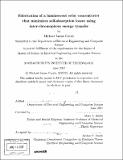Fabrication of a luminescent solar concentrator that minimizes self-absorption losses using inter-chromophore energy transfer
Author(s)
Currie, Michael James
DownloadFull printable version (5.030Mb)
Other Contributors
Massachusetts Institute of Technology. Dept. of Electrical Engineering and Computer Science.
Advisor
Marc A. Baldo.
Terms of use
Metadata
Show full item recordAbstract
The projected need for carbon-free power during this century is immense. Solar power offers the largest resource base to supply this need, but in light of recent silicon shortages, it is an open question whether silicon photovoltaics can keep pace with demand. The development of economical concentrators could relieve this resource pressure. The luminescent solar concentrator (LSC) is an architecture that collects and concentrates light using the luminescent properties of chromophores embedded in a waveguide. This method of concentration alleviates the need for expensive tracking equipment necessary for optical concentration. Combined with the low cost and flexible fabrication of organic materials, this technology is inherently scalable. A major limitation to LSC efficiency is self-absorption between different chromophores within the waveguide. Finding inspiration from the architecture of phycobilisome antenna complexes, a system of chromophores is developed that minimizes self-absorption through Firster energy transfer. Precise control of intermolecular spacing is achieved through thermal evaporation of small molecule organics. A LSC with a geometric gain of 25 is fabricated that employs this optimized system. External quantum efficiencies of 32% are achieved across nearly half the visible spectrum, with a total power conversion efficiency of 1.6%. Additionally, modeling and theory are presented to highlight places for device improvement. It is shown that a simple path integral successfully captures the dynamics of the LSC.
Description
Thesis (S.M.)--Massachusetts Institute of Technology, Dept. of Electrical Engineering and Computer Science, 2007. Includes bibliographical references (p. 57-59).
Date issued
2007Department
Massachusetts Institute of Technology. Department of Electrical Engineering and Computer SciencePublisher
Massachusetts Institute of Technology
Keywords
Electrical Engineering and Computer Science.